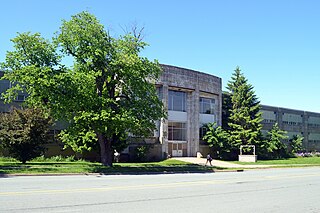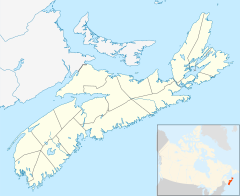
Halifax Stanfield International Airport is a Canadian airport in Goffs, Nova Scotia, a rural community of the Halifax Regional Municipality. It serves the Halifax region, mainland Nova Scotia, and adjacent areas in the neighbouring Maritime provinces. The airport is named in honour of Robert Stanfield, the 17th Premier of Nova Scotia and former leader of the federal Progressive Conservative Party of Canada.
Gerald Augustine Paul Regan was a Canadian politician, who served as the 19th premier of Nova Scotia from 1970 to 1978.
The Westray Mine was a Canadian coal mine in Plymouth, Nova Scotia. Westray was owned and operated by Curragh Resources Incorporated, which obtained both provincial and federal government money to open the mine, and supply the local electric power utility with coal.

St. Margarets Bay is a bay located on the Atlantic coast of Nova Scotia, Canada on the border of Halifax County and Lunenburg County.

The Dominion Atlantic Railway was a historic railway which operated in the western part of Nova Scotia in Canada, primarily through an agricultural district known as the Annapolis Valley.

The St. Regis Toronto is a mixed-use skyscraper located in the downtown core of Toronto, Ontario, Canada. It was built by Markham-based Talon International Development Inc., which is owned by Canadian businessmen Val Levitan and Alex Shnaider. The hotel portion of the building is owned by InnVest Hotels LP, which acquired it in 2017.

St. Patrick's High School was a non-denominational school centrally located on Quinpool Road in Halifax, Nova Scotia, Canada. Historically a Roman Catholic public school, St. Pat's opened in 1954 less than one block from its rival non-denominational public school, Queen Elizabeth High (QEH). St. Patrick's closed in 2007, merging with QEH to form Citadel High School. The school building was demolished in 2015.
The Aspotogan Peninsula is a peninsula in the eastern part of Lunenburg County, Nova Scotia, separating St. Margarets Bay in the east from Mahone Bay in the west. The peninsula was originally settled by second generation French immigrants on the east side and by second generation German immigrants on the west side. Traditionally fishing was a major industry for communities throughout the peninsula, however other primary industries such as farming and forestry were historically important as well. Shipping and shipbuilding were secondary and tertiary industries that also came into prominence during the 19th and early 20th centuries.

Purdy's Wharf is an office complex in Halifax, Nova Scotia, Canada. Built over the water at the edge of Halifax Harbour and resting on pilings, it consists of two office towers, and a smaller office structure called Purdy's Landing. The complex is located along the Halifax Waterfront Boardwalk.

The Maritime Centre, in Downtown Halifax, Nova Scotia, Canada, is an office building, home to the regional telecommunications company Bell Aliant. The main entrance to the building sits on the prominent corner of Barrington Street and Spring Garden Road.

The Westin Nova Scotian is a Canadian hotel located in Halifax, Nova Scotia, owned and operated by New Castle Hotels and Resorts. It was built in 1928 by the Canadian National Railway as the Nova Scotian Hotel and after several changes of owners and names in the late 20th century became the Westin Nova Scotian in 1996.
Saint Mary's University (SMU) is a formerly Catholic, public university located in Halifax, Nova Scotia, Canada. The school is best known for having nationally leading programs in business and chemistry. The campus is situated in Halifax's South End and covers approximately 32 hectares.

Berwick is a Canadian town in Kings County, Nova Scotia. The town is located in the eastern part of the Annapolis Valley on the Cornwallis River. The town site stretches south from the river and Exit 15 of Highway 101 to Highway 1. Berwick occupies 6.80 km2 and has an elevation of 43 m (141 ft) above sea level.

The Texpark site is a prominent vacant lot in Downtown Halifax, Nova Scotia. The Coast, a weekly newspaper, has called it "downtown's biggest gaping hole" and an "embarrassing missing tooth" in the urban fabric. Much of the site was once home to the Texpark, a city-owned parking garage, demolished in 2004.
Canadian Forces Station Mill Cove is a former Canadian Forces Station and currently a naval radio station located near Hubbards, Nova Scotia. Built in 1967, it is remotely operated by the Canadian Forces from CFB Halifax.

The RBC Waterside Centre is a commercial development in the downtown core of Halifax, Nova Scotia, Canada built by local real estate developer Armour Group. The project involves demolishing six heritage buildings and replacing them with a nine storey retail and office building, clad at ground level with the reconstructed facades of most of the former heritage buildings.

The Sweet Basil Building, also known as the P. Martin Liquors Building, was a heritage building on the waterfront of Halifax, Nova Scotia, Canada which was demolished by Halifax developer Armour Group in November 2008 as part of the company's controversial Waterside Centre Development proposal.

Shangri-La Toronto is a luxury hotel and residential condominium building in downtown Toronto, Ontario, Canada. It was designed by James K. M. Cheng and built by Westbank Projects Corp.; they also designed and built the Living Shangri-La in Vancouver. The building is 214 meters tall and is one of the fifteen tallest buildings in Toronto. The hotel component is run by Shangri-La Hotels and Resorts and has 202 guest rooms and suites. The condominium portion occupies the upper floors of the building and consists of 393 units. Excavation of the site started in 2008, and work on the parking garage began in early 2009.

Nova Centre is a mixed-use commercial development under construction in downtown Halifax, Nova Scotia, Canada. It comprises a hotel tower, two office towers, the new Halifax Convention Centre, retail space, and Grafton Place, a public pedestrian arcade that was formerly part of Grafton Street. It is being developed at a cost of $500 million by Halifax developer Argyle Developments Ltd.















